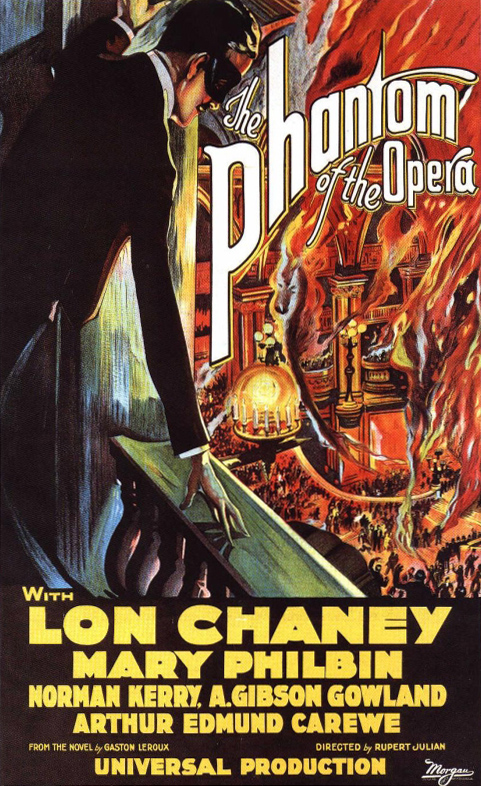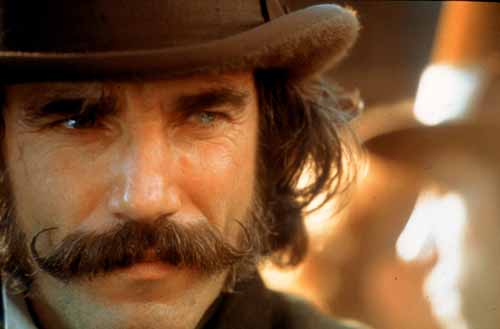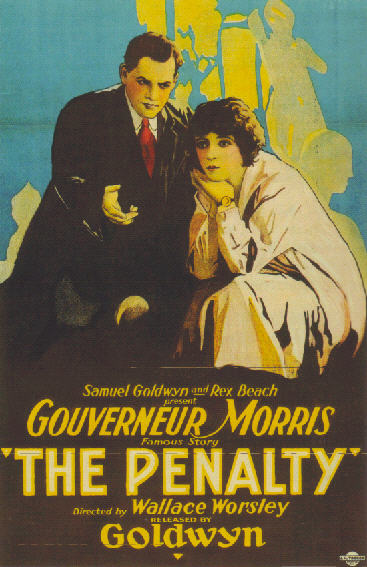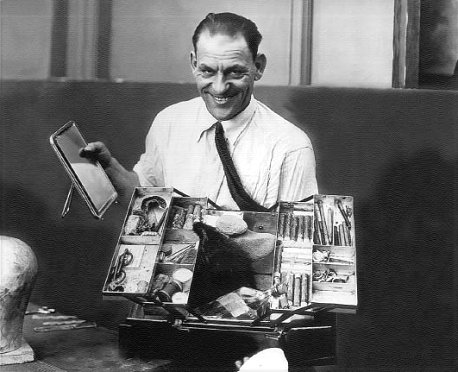American
popular literature has a long grotesque tradition, stretching back to
Washington Irving, our first literary celebrity. It achieved its
apotheosis, in terms of both sensationalism and art, in the work of
Edgar Allen Poe — and it migrated naturally into the exaggerated
conventions of Victorian theater, and from there into movies.
After
WWI, and perhaps in part owing to the unprecedented horrors of that
conflict, grotesque melodrama became a distinct genre in cinema, much
as film noir became a distinct genre after the collective nightmare of
WWII. Its power and prestige is best illustrated by the extraordinary
popularity of Lon Chaney. One of the most celebrated stars of the
silent era, he specialized almost exclusively in the genre of the
grotesque. (He's seen above in and out of make-up for The Miracle Man.)
In
tracing the rise of the modern horror film from its roots in silent
cinema, we can easily misconstrue the grotesque genre as it was
experienced by early audiences. The Phantom Of the Opera and The
Hunchback of Notre Dame, proto-horror films starring Chaney, actually
have more in common with a grotesque contemporary melodrama like The
Penalty, also starring Chaney as a legless underworld crime boss —
and the three have more in common with each other than any of them has
with Dracula, for example, with its supernatural elements, or even Frankenstein, with its elements of mad-science fiction.
The
Phantom, the Hunchback, and the legless Blizzard from The Penalty are
all disfigured men whose afflictions have rendered them terrifying,
while not quite extinguishing the romantic souls within. It's hard not
to see in this an echo of the many thousands of mutilated survivors of
WWI, and a metaphor for the psyche of a world scarred by previously
unimaginable battlefield carnage.
The
word grotesque does not quite describe the dramatic tone of The
Penalty or the world it creates. Demented is closer to the mark. It
does not present us with a vision of normality penetrated by grotesque
elements — it is set in a universe which has become unhinged at the
core, and this nightmare universe is delineated matter-of-factly, as
though its logic were the logic of the world as it is.
This
creates a wonderful, dreamy kind of surrealism, with great poetic
force, and a delightful atmosphere of frisson — but it is finally very
disturbing. One is tempted for this very reason to dismiss it as lurid
pulp, but one cannot — mostly because of the authority of Chaney . . .
the physical authority of his shockingly convincing impersonation of a
legless man, and the artistic authority of his performance as the
paradoxical Blizzard.
We are
given to drawing a distinction between silent film performers who
“over-acted” and those who played in a more restrained and “modern”
style. Chaney is usually considered more modern in this sense. But in
truth, Chaney overacts in every frame of The Penalty, by modern
standards. It's just that the broad strokes of his expressions and
gestures are so grounded in psychological truth, so complex in their
suggestiveness, so graceful and sublime in their execution, that we are
swept beyond our modern expectations of what acting should be. We are
experiencing screen performance as audiences of the time experienced
it.
The
intimacy of the camera certainly did require a technical toning down of
physical expression and gesture for actors coming from the stage —
much as a smaller theatrical venue would have for actors accustomed to
playing huge auditoriums — and there were certainly lunkheaded actors
who couldn't pull this off. But most of the time, when we talk about
the difference between over-acting and more naturalistic acting in
silent films, we are simply noting the difference between bad acting
and good acting.
One of
Cocteau's great maxims was “You have to know when it's all right to go
too far.” Great silent film actors knew this — and great modern actors
know it, too. James Cagney and Jack Palance — and Jack Nicholson, for that
matter — habitually overact by so-called modern standards, yet their
performances still seem fresh and convincing, perfectly au courant.
Daniel Day Lewis's performance in The Gangs Of New York, one of the
very greatest performances ever committed to film, is as wild and
over-the-top as any silent film performance ever was, and yet it is a
work of complicated and compelling genius.
The
camera did allow a new breed of actors to step to the fore — the
minimalists, of whom Robert de Niro is probably the most astonishing.
But Lon Chaney was no minimalist. He was an actor in the grand style —
and, quite simply, a supreme master of that style, consistently
pitch-perfect, and consistently breathtaking.
The
delirious tale of The Penalty begins with a boy injured in a traffic
accident, treated by an incompetent doctor who unnecessarily amputates
both his legs. An older doctor covers for the younger physician's
mistake, and the chastened bumbler goes on to an exemplary career in
medicine. But the boy never forgets.
He grows up to be the crippled criminal mastermind Blizzard, played by Chaney, who amasses power, covets more, and plans
his revenge — on the doctor and on the world.
On
the first front, he insinuates himself into the life of the doctor's
daughter — a sculptor torn between her ambitions as an artist and
society's expectations of exemplary womanhood (domestic and submissive)
— by posing for her portrait of Satan. On the second front he is
plotting a takeover of the city of San Francisco by means of a lunatic
scheme involving ten thousand “foreign malcontents”, armed to the
teeth, and uniformed in silly matching straw hats, cunningly woven in
advance by harlots conscripted from the ranks of Blizzard's working
girls.
It's all quite mad, but presented as an authentic threat to the civil order.
A
subplot involves a plucky undercover female police operative who
infiltrates the crucial straw hat operation and quickly learns more
than it's safe for her to know. Principally she discovers the
underground lair where Blizzard stores the munitions for his planned
insurrection — a subterranean world, reached through a trick
fireplace, that's right out of the wildest Gothic fiction, and vaguely
reminiscent of Erik the Phantom's underground kingdom beneath the
Opera.
Blizzard is a beast, with the soul of a poet. He is a fine critic of art, and fires the sculptor with the courage she
needs to break free of her bourgeois shackles and strike out on her own for glory. Villain indeed!
Blizzard
also wins the heart of the undercover operative by his soulful piano
paying — and she wins his by her skillful operation of the pedals
while he plays. She comes to her senses only when she discovers that
his grand plan involves amputating the legs of a certain . . . but you
get the idea.
Female independence is presented as possibly sexy and possibly admirable but, in the end, a very bad idea, for which a
woman will inevitably pay a dreadful price.
The
preposterous villainy resembles the harebrained villainy of Feuillade's
serials — at once innocent and unsettling, mundane and surreal.
Possibly both reflect a post-war malaise informed by a sense that the
ordinary world has gone subtly but irrevocably insane.
Chaney's
performance, as usual, gives it all an unlikely interior coherence and
logic. The filmmaking is aptly described by Michael Blake, Chaney's
biographer, as craftsmanlike — the shots are handsomely framed and
lit, and the narrative moves along at a lively clip. Chaney alone
elevates the film to greatness.
Every
time he moves himself around with his crutches or with his hands alone,
we watch a ballet on stumps unfold — the aesthetic determination and
commitment of the actor become the villainous determination and
commitment of the character he's playing. We admire him and recoil from
him at the same time.
This
is the thrill of the grotesque drama. We are allowed to engage and
embrace our deepest fears and discontents subconsciously, while
retaining our outward allegiance to conventional virtues. The film
dangles the possibility of Blizzard's redemption before us — then
snatches it away at the last moment . . . as it snatches away the
possibility of new horizons for the women.
The
ultimate effect, however, is one of ambiguity, a suspension of faith in
the old certainties — an intriguing discombobulation of the moral
universe.

Kino's
edition of the film on DVD features a splendid print and some wonderful
extras. They include the surviving footage from The Miracle Man —
which is painful to watch, because this lost film looks as though it
might have been marvelous. Included also is one of the few surviving
one-reelers from Chaney's early years at Universal — By the Sun's
Rays. It's not much of a film, but it's fascinating to see Chaney at
work at the beginning of his movie career. His physical grace commands
attention, even when his choices as an actor are obvious or even crude.
Chaney was born for the screen, as Chaplin and Pickford were — with an
instinctive insight into the movies's mysterious expressive power.
There
is, perhaps most delightfully of all, a brief short in which Michael
Blake shows us some of the Chaney artifacts held by the Los Angeles
Museum of Natural History. We see the suit and the stumps Chaney wore
in the movie, his make-up case — the mirror he looked into while
working his magic. Blake handles them all with the delicate hands of a
make-up artist, which he is — and the awed respect of someone who
genuinely admires the craft of a master.
